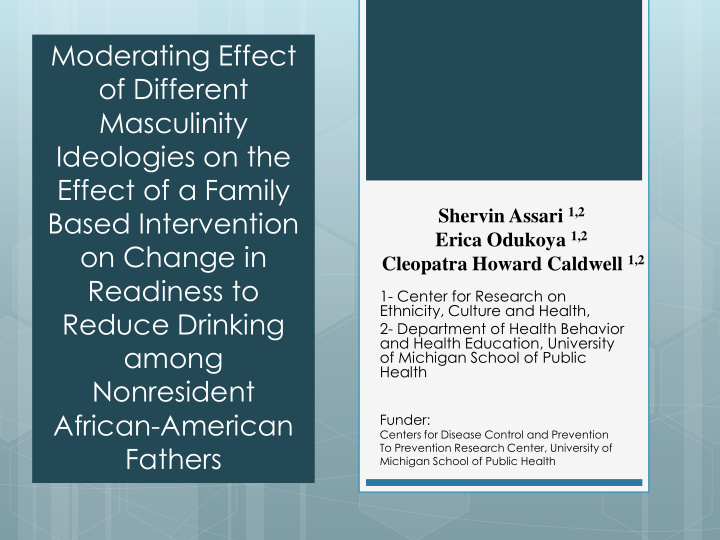



Moderating Effect of Different Masculinity Ideologies on the Effect of a Family Based Intervention Shervin Assari 1,2 Erica Odukoya 1,2 on Change in Cleopatra Howard Caldwell 1,2 Readiness to 1- Center for Research on Ethnicity, Culture and Health, Reduce Drinking 2- Department of Health Behavior and Health Education, University among of Michigan School of Public Health Nonresident African-American Funder: Centers for Disease Control and Prevention Fathers To Prevention Research Center, University of Michigan School of Public Health
Objectives Describe the Fathers and Sons Program Explain how the program has been evaluated Present the findings of the current study Discuss implications of these findings on future intervention work
The Fathers and Sons Study Fathers and Sons Intervention Family-based Non-resident fathers and son Reduce risky behaviors Strengthen: Relationship between fathers and sons Fathers’ parenting behaviors Sons’ refusal skills Sons’ intentions to avoid risky behaviors Mitka M. Lifestyle modification and heart disease: researchers not deterred by trials showing no benefit. JAMA. 2009 Jan 14;301(2):150-1. doi: 10.1001/jama.2008.916.
Defining Non-Resident Fathers Father: Self-identified African American or Black biological father of a boy in the intervention Non-Resident: The son did not sleep over at their father’s home more than half of the time during the year
The Fathers and Sons Study Intervention Questions Three main questions Effectiveness? Mechanisms? Who benefits?
The Fathers and Sons Study Effectiveness Fathers and Sons is an effective family based intervention Among fathers, the intervention was promising for enhancing parental monitoring, communication about sex, intentions to communicate, race-related socialization practices parenting skills satisfaction The intervention was also beneficial for sons: reported more monitoring by their fathers improved communication about sex increased intentions to avoid violence Caldwell CH, Rafferty J, Reischl TM, De Loney EH, Brooks CL. 2010
The Fathers and Sons Study Mechanisms Ongoing studies Caldwell, et al. (2013): The effect of intervention on sons’ aggressive behaviors and intention to avoid violence in future is significant, but indirect, through parenting. Caldwell C, Antonakos C, Assari S, Kruger, D, de Loney E. , Njai R, 2013
The current question: Who benefits more from the intervention?
The Fathers and Sons Study Related research Masculinity beliefs Substance use Parenting / family function Masculinity is associated with substance use (1). Masculinity is also linked to parenting behaviors (2). Substance abuse may also interfere with effective parenting (3, 4). 1- Garfield et al., 2008, 2- Caldwell, Antonakos, Tsuchiya, Assari, & De Loney, 2012, 3- Jacob, Harber, Leonard & Rushe, 2000, 4- Eiden et al. 2004
The Fathers and Sons Study Previous Work Relationships between masculinity ideologies, perceived discrimination, and parenting behaviors on depression and drinking Masculinity ideologies as moderators Masculinity ideologies are multidimensional; differentially associated with depressive symptoms, connectedness with son, and co-parenting
The Fathers and Sons Study Current Study Masculine Ideologies Readiness to Fathers & Reduce Sons Drinking Sample: 229 fathers who reported drinking alcohol (135 intervention and 94 comparison group)
AA Men & Alcohol Use African-Americans report significantly higher numbers of drinking consequences and alcohol dependence symptoms (Grant 1997; Herd 1994a) High rates of escape or personal effects drinking (Martin, Tuch and Roman, 2003) Stressors associated with disadvantaged minority status influence alcohol use. (Martin, Tuch and Roman, 2003)
Masculinity Ideologies Hegemonic masculinity Culturally-based masculinity Interconnected masculinity Masculinity Norms Salience Scale (Hammond & Mattis, 2005)
Hegemonic Masculinity Power, prestige, status; physical toughness, competitiveness, autonomy, emotional detachment Associations with risky health behaviors
Hegemonic Masculinity Measured via 5 items Having power Being a good athlete Being physically strong Being in control of a relationship Preventing others from taking advantage of you
Racial Differences Conflicting literature Racism and discrimination in the American context may limit AA men’s ability to achieve hegemonic masculinity Cultural and historical context is important to consider Consistency in literature AA also endorse less traditional masculine norms 12- McClure, 2006; 13- Speer, 2001, 14- Obama, 2006, 15- Matthews & Williams, 2007; 16- White & Cones, 1999
Culturally Based Masculinity Emotional expressiveness Measured via 8 items Expressing love for family and friends Being dependable Being a good provider Being successful in one’s job Protecting one’s self and family Being a good role model for others Being a good parent Being responsible
Interconnected Masculinity Communal, egalitarian, spiritual Measured via 4 items Being caring towards others Fighting for the rights of others Giving something back to the community Having the respect of others
Drinking Behavior Do you intend to stop or reduce your drinking within the next six months? Answers: Yes or No
The Fathers and Sons Study Analysis Logistic regression models Model 1: effect of intervention and masculinity ideologies on Time 2 intention to reduce drinking Model 2: Interaction between intervention and masculinity ideologies Controls: Time 1 intention to reduce drinking Time 1 drinking frequency Age, education level, and time lived with son
The Fathers and Sons Study Model 1 Intention to reduce drinking was higher among those with higher hegemonic masculinity (OR=1.092, 95% CI=1.010 - 1.181).
The Fathers and Sons Study Model 2 The effect of the intervention on readiness to reduce drinking was larger among men with higher interconnected (OR=1.655 1.100-2.489) and lower cultural-based masculinity (OR=.721, 95% CI=.540-.963).
Discussion Model 1 More aware of problem behavior Model 2 Interconnected could influence change Further research is needed
The Fathers and Sons Study Implications Fathers’ readiness to reduce drinking may depend on different masculinity ideologies Tailoring interventions Clinical practice Flegal KM, Carroll MD, Kit BK, Ogden CL. Prevalence of obesity and trends in the distribution of body mass index among US adults, 1999- 2010. JAMA. 2012 Feb 1;307(5):491-7.
The Fathers and Sons Study Thank you
Recommend
More recommend